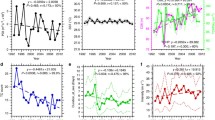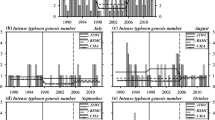Abstract
This study shows that the occurrence of intense typhoons in the western North Pacific is significantly higher in the autumns of the Central Pacific (CP), compared to Eastern Pacific El Niño years. Specifically, (1) The higher occurrence of intense typhoons in CP El Niño autumns is related to a longer typhoon lifespan, maximum potential intensity, ocean heat content, vertical shear of the zonal wind (850–200 hPa), outgoing long-wave radiation, and moist static energy averaged over 1,000–500 hPa. (2) A longer typhoon lifespan in CP El Niño autumns is caused by the westward shift of the subtropical high, which tends to steer typhoon to the west and northwest.








Similar content being viewed by others
References
Anthes RA et al (2006) Hurricanes and global warming-potential linkages and consequences. Bull Am Meteorol Soc 87(5):623–628
Ashok K et al (2007) El Niño Modoki and its possible teleconnection. J Geophys Res 112:C11007
Bengtsson L, Lighthill J, Pearce RP (1982a), The factors determining radial flow and eye formation in an intensifying tropical cyclone. In: Ghil M, Sadourny R, Sundermann J (eds) Intense atmospheric vortices. Topics in atmospheric and oceanographic sciences. Springer, Berlin, pp 131–146
Bengtsson L, Lighthill J, Gray WM (1982b) Tropical cyclone genesis and intensification. In: Ghil M, Sadourny R, Sundermann J (eds) Intense atmospheric vortices. Topics in atmospheric and oceanographic sciences. Springer, Berlin, pp 3–20
Bister M, Emanuel KA (2002) Low frequency variability of tropical cyclone potential intensity, 1, Interannual to interdecadal variability. J Geophys Res 107(D24):4801. doi:10.1029/2001JD000776
Camargo SJ (2013) Global and regional aspects of tropical cyclone activity in the CMIP5 models. J Clim 26:9880–9902
Camargo SJ, Sobel AH (2005) Western North Pacific tropical cyclone intensity and ENSO. J Clim 18(15):2996–3006
Camargo SJ, Robertson AW, Gaffney SJ, Smyth P, Ghil M (2007) Cluster analysis of typhoon tracks. Part II: Large-scale circulation and ENSO. J Clim 20(14):3654–3676
Carton JA, Chepurin G, Cao X, Giese BS (2000a) A simple ocean data assimilation analysis of the global upper ocean 1950–1995, Part 1: methodology. J Phys Oceanogr 30:294–309
Carton JA, Chepurin G, Cao X (2000b) A simple ocean data assimilation analysis of the global upper ocean 1950–1995 Part 2: results. J Phys Oceanogr 30:311–326
Chan JCL (2006) Comment on “changes in tropical cyclone number, duration, and intensity in a warming environment”. Science 311(5768):1713
Chan JCL (2007) Interannual variations of intense typhoon activity. Tellus A 59(4):455–460
Chan JCL (2008) Decadal variations of intense typhoon occurrence in the western North Pacific. Proc R Soc A-Math Phys Eng Sci 464(2089):249–272
Chan JCL, Liu K (2004) Global warming and western north pacific typhoon activity from an observational perspective. J Clim 17:4590–4602
Chen G (2011) How does shifting Pacific Ocean warming modulate on tropical cyclone frequency over the South China Sea? J Clim 24:4695–4700
Chen G, Tam C-Y (2010) Different impacts of two kinds of Pacific Ocean warming on tropical cyclone frequency over the western North Pacific. Geophys Res Lett 37(1):L01803
Craig G, Gray S (1996) CISK or WISHE as the mechanism for tropical cyclone intensification. J Atmos Sci 53(23):3528–3540
DeMaria M (1996) The effect of vertical shear on tropical cyclone intensity change. J Atmos Sci 53(14):2076–2088
DeMaria M, Kaplan J (1994) Sea surface temperature and the maximum intensity of Atlantic tropical cyclones. J Clim 7(9):1324–1334
Di Lorenzo E et al (2010) Central Pacific El Niño and decadal climate change in the North Pacific Ocean. Nat Geosci 3(11):762–765
Dowdy AJ et al (2012) Tropical cyclone climatology of the South Pacific Ocean and its relationship to El Niño-Southern oscillation. J Clim 25(18):6108–6122
Emanuel KA (1986) An air-sea interaction theory for tropical cyclones. Part I. J Atmos Sci 42:1062–1071
Emanuel KA (1988) The maximum intensity of Hurricanes. J Atmos Sci 45:1143–1155
Emanuel KA (1995) Sensitivity of tropical cyclones to surface exchange coefficients and a revised steady-state model incorporating eye dynamics. J Atmos Sci 52:3969–3976
Emanuel KA (1997) Some aspects of hurricane inner-core dynamics and energetics. J Atmos Sci 54:1014–1026
Emanuel KA (1999) Thermodynamic control of hurricane intensity. Nature 401:665–669
Emanuel KA (2013) Downscaling CMIP5 climate models shows increased tropical cyclone activity over the 21st century. Proc Natl Acad Sci 110:12219–12224
Gray WM (1968) Global view of origin of tropical disturbances and storms. Mon Weather Rev 96(10):669–700
Gray WM (1998) The formation of tropical cyclones. Meteorol Atmos Phys 67(1–4):37–69
Ha Y, Zhong Z, Yang X, Sun Y (2013) Different Pacific ocean warming decaying types and Northwest Pacific tropical cyclone activity. J Clim 26:8979–8994
Hong C-C et al (2011) Impacts of central Pacific and eastern Pacific El Niños on tropical cyclone tracks over the western North Pacific. Geophys Res Lett 38(16):L16712
Huang F, Xu S (2010) Super typhoon activity over the western North Pacific and its relationship with ENSO. J Ocean Univ China 9(2):123–128
Kalnay E et al (1996) The NCEP/NCAR 40-year reanalysis project. Bull Am Meteorol Soc 77(3):437–471
Kamahori H et al (2006) Variability in intense tropical cyclone days in the Western North Pacific. SOLA 2:104107
Kanada S, Wada A, Sugi M (2013) Future changes in structures of extremely intense tropical cyclones using a 2-km mesh nonhydrostatic model. J Clim 26(24):9986–10005
Kim ST, Yu J-Y (2012) The two types of ENSO in CMIP5 models. Geophys Res Lett 39:L11704
Kim HM et al (2009) Impact of shifting patterns of Pacific Ocean warming on North Atlantic tropical cyclones. Science 325(5936):77
Kim H-M et al (2011) Modulation of North Pacific tropical cyclone activity by three phases of ENSO. J Clim 24(6):1839–1849
Klotzbach PJ (2006) Trends in global tropical cyclone activity over the past twenty years (1986–2005). Geophys Res Lett 33(10):L10805
Knapp Kenneth R, Knaff John A, Sampson Charles R, Riggio Gustavo M, Schnapp Adam D (2013) A pressure-based analysis of the historical western north pacific tropical cyclone intensity record. Mon Weather Rev 141:2611–2631
Knutson TR, McBride JL, Chan J, Emanuel K, Holland G, Landsea C, Held I, Kossin JP, Srivastava A, Sugi M (2010) Tropical cyclones and climate change. Nat Geosci 3(3):157–163
Kossin J, Knapp K, Vimont D, Murnane R, Harper B (2007) A globally consistent reanalysis of hurricane variability and trends. Geophys Res Lett 34(4):L04815
Kug J-S et al (2009) Two types of El Niño events: cold tongue El Niño and warm pool El Niño. J Clim 22(6):1499–1515
Kug J-S, Ham Y-G, Lee J-Y, Jin F-F (2012) Improved simulation of two types of El Niño in CMIP5 models. Environ Res Lett 7:034002
Kurihara Y (1976) On the development of spiral bands in a tropical cyclone. J Atmos Sci 33:940–958
Landsea CW et al (2006) Can we detect trends in extreme tropical cyclones? Science 313(5786):452–454
Lee S-K et al (2010) On the impact of central Pacific warming events on Atlantic tropical storm activity. Geophys Res Lett 37(17):L17702
Li RCY, Zhou W (2012) Changes in western pacific tropical cyclones associated with the El Niño-Southern oscillation cycle. J Clim 25(17):5864–5878
Liebmann B, Smith CA (1996) Description of a complete (Interpolated) outgoing longwave radiation dataset. Bull Am Meteorol Soc 77:1275–1277
Lin II, Wu CC, Pun I-F (2008) Upper ocean thermal structure and the western North Pacific category-5 typhoons—Part I: ocean features and category-5 typhoons. Mon Weather Rev 136(9):3288–3306
Lin II, Pun I-F, Wu C-C (2009) Upper ocean thermal structure and the western North Pacific category-5 typhoons Part II: dependence on translation speed. Mon Weather Rev 137(11):3744–3757
Lin II, Goni G, Knaff J, Forbes C, Ali MM (2013a) Ocean heat content for tropical cyclone intensity forecasting and its impact on storm surge. Nat Hazards 66:1481–1500
Lin I-I, Black P, Price JF, Yang C-Y, Chen SS, Lien C-C, Harr P, Chi N-H, Wu C-C, D’Asaro EA (2013b) An ocean coupling potential intensity index for tropical cyclones. Geophys Res Lett 40:1878–1882. doi:10.1002/grl.50091
McTaggart-Cowan R et al (2007) Hurricane Katrina (2005). Part I: complex life cycle of an intense tropical cyclone. Mon Weather Rev 135(12):3905–3926
Merrill RT (1988) Environmental influences on hurricane intensification. J Atmos Sci 45:1678–1687
Murakami H, Wang B, Kitoh A (2011) Future change of western North Pacific typhoons: projections by a 20-km-mesh global atmospheric model*. J Clim 24(4):1154–1169
Murakami H, Wang Y, Yoshimura H, Mizuta R, Sugi M, Shindo E, Adachi Y, Yukimoto S, Hosaka M, Kusunoki S, Ose T, Kitoh A (2012) Future changes in tropical cyclone activity projected by the new high-resolution MRI-AGCM*. J Clim 25:3237–3260
Powell MD, Aberson SD (2001) Accuracy of United States tropical cyclone landfall forecasts in the Atlantic basin (1976–2000). Bull Am Meteorol Soc 82(12):2749–2767
Pradhan P, Preethi B, Ashok K, Krishnan R, Sahai A (2011) Modoki, Indian Ocean Dipole, and western North Pacific typhoons: possible implications for extreme events. J Geophys Res 116(D18):D18108
Rayner N et al (2003) Global analyses of sea surface temperature, sea ice, and night marine air temperature since the late nineteenth century. J Geophys Res 108(D14):4407
Scharroo R, Smith WHF, Lillibridge JL (2005) Satellite altimetry and the intensification of hurricane Katrina. EOS Trans AGU 86:366
Shay LK, Goni GJ, Black PG (2000) Effects of a warm oceanic feature on Hurricane Opal. Mon Weather Rev 128:1366–1383
Taschetto AS, Gupta AS, Jourdain NC, Santoso A, Ummenhofer CC, England MH (2014) Cold tongue and warm pool ENSO events in CMIP5: mean state and future projections. J Clim 27:2861–2885
Tu JY et al (2011) An abrupt increase of intense typhoons over the western North Pacific in early summer. Environ Res Lett 6(3):034013
Wada A, Chan JCL (2008) Relationship between typhoon activity and upper ocean heat content. Geophys Res Lett 35:L17 603
Wang B, Chan JCL (2002) How strong ENSO events affect tropical storm activity over the Western North Pacific. J Clim 15:1643–1658
Wang C, Li C, Mu M, Duan W (2013) Seasonal modulations of different impacts of two types of ENSO events on tropical cyclone activity in the western North Pacific. Clim Dyn 40:2887–2902
Webster PJ, Holland GJ, Curry JA, Chang H-R (2005) Changes in tropical cyclone number, duration, and intensity in a warming environment. Science 309(5742):1844–1846
Weng H, Ashok K, Behera SK, Rao SA, Yamagata T (2007) Impacts of recent El Niño Modoki on dry/wet conditions in the Pacific rim during boreal summer. Clim Dyn 29(2):113–129
Wu L, Zhao H (2012) Dynamically derived tropical cycloneintensity changes over the Western North Pacific. J Clim 25(1):89–98
Yeh S-W, Kug J-S, Dewitte B, Kwon M-H, Kirtman BP, Jin F-F (2009) El Niño in a changing climate. Nature 461(7263):511–514
Zhang W, Graf H, Leung Y, Herzog M (2012) Different El Niño types and tropical cyclone landfall in East Asia. J Clim 25(19):6510–6523
Zhang W, Leung Y, Min J-Z (2013) North Pacific gyre oscillation and the occurrence of western North Pacific tropical cyclones. Geophys Res Lett 40(19):5205–5211
Acknowledgments
This research was jointly supported by the Geographical Modeling and Geocomputation program under the Focused Innovation Scheme of The Chinese University of Hong Kong, Open Research Funding Program of KLGIS of Ministry of Education at East China Normal University (Grant No. KLGIS2012A04), the Startup Foundation for Introducing Talent of NUIST, the Priority Academic Program Development (PAPD) of Jiangsu Higher Education Institutions, Jiangsu Natural Science Funds for Distinguished Young Scholar (BK20140047) and National Natural Science Foundation of China (Grant No.: 41201045).
Author information
Authors and Affiliations
Corresponding author
Rights and permissions
About this article
Cite this article
Zhang, W., Leung, Y. & Fraedrich, K. Different El Niño types and intense typhoons in the Western North Pacific. Clim Dyn 44, 2965–2977 (2015). https://doi.org/10.1007/s00382-014-2446-4
Received:
Accepted:
Published:
Issue Date:
DOI: https://doi.org/10.1007/s00382-014-2446-4




